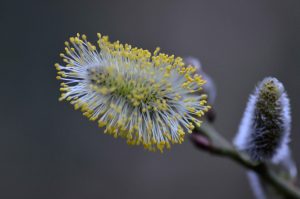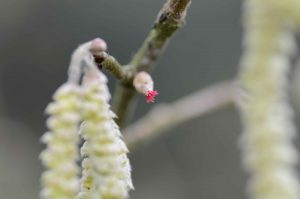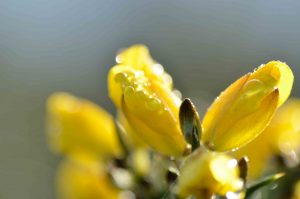“At the beginning of all things when life was new, the Snow sought to borrow a colour. The flowers were much admired by all the elements but they guarded their colour’s jealousy and when the Snow pleaded with them, they turned their backs in contempt for they believed the Snow cold and unpleasant. The tiny humble snowdrops took pity on the Snow for none of the other flowers had shown it any kindness and so they came forth and offered up to the Snow their colour.
The Snow gratefully accepted and became white forevermore, just like the Snowdrops. In its gratitude, the Snow permitted the little pearly flowers the protection to appear in winter, to be impervious to the ice and bitter chill. From then on, the Snow and the Snowdrops coexisted side by side as friends.”
This wonderful folklore tale is recited beautifully with more fascinating insights at
http://www.creativecountryside.com/blog/the-folklore-of-snowdrops
We are not the only ones drawn to the beautiful snowdrops hiding in the hedgerow. This hoverfly seeks much-needed nectar and pollen in the cold winter months as do many early insects. Hibernating insects such as bumblebees and butterflies emerge as soon as the weather warms desperate to feed
After the recent report on the frighting forecast of the demise of the worlds insect numbers, and the devastating repercussion this will have on the planet’s ecosystems, we owe to our selves to learn more about how we can help our insect friends to recovery.
Basic practice
I believe one of our worst hindrances to better practice is our mental need to apply the neet and tidy approach to our outside spaces, in my work I am consistently asked to Manicure the lawns and borders, tidy and burn leaf piles, remove cut branches, and generally produce a sterile living room like environment outside. Let’s learn to look at the beauty of Wildflower meadow and ordered debris pile as something to cherish. If you are looking for a bird in late winter notice how the congregate around the leaf litter and the long grass, diving into the cover of your log and branch pile, feeding on the endless supply of insects to be found there, while if you lucky a hedgehog sleeps the winter.
As for the insects, none of the above including us will live to enjoy the future without them.
Please watch this Youtube Vidio.
The global review, published in the journal Biological Conservation last week, stated that the world was witnessing the “largest extinction event on Earth” for millions of years, in the face of habitat loss, pesticides, disease and invasive species and climate change.
https://www.eadt.co.uk/business/suffolk-wildlife-trust-reacts-to-report-on-decline-of-insect-numbers-1-5894812
The world’s insects are hurtling down the path to extinction, threatening a “catastrophic collapse of nature’s ecosystems”, according to the first global scientific review.
More than 40% of insect species are declining, and a third are endangered, the analysis found. The rate of extinction is eight times faster than that of mammals, birds and reptiles. The total mass of insects is falling by a precipitous 2.5% a year, according to the best data available, suggesting they could vanish within a century.
The planet is at the start of a sixth mass extinction in its history, with huge losses already reported in larger animals that are easier to study. But insects are by far the most varied and abundant animals, outweighing humanity by 17 times. They are “essential” for the proper functioning of all ecosystems, the researchers say, as food for other creatures, pollinators and recyclers of nutrients.
“Unless we change our ways of producing food, insects as a whole will go down the path of extinction in a few decades,” they write. “The repercussions this will have for the planet’s ecosystems are catastrophic to say the least.”
https://www.theguardian.com/environment/2019/feb/10/plummeting-insect-numbers-threaten-collapse-of-nature
Plants and Flowers that can help in the winter and early Spring
December/February onwards-
Muscari Neglectum
(Grape Hyacinth)
Clematis cirrhosa Spanish traveller’s joy
Crocus species crocus (winter-flowering)
Eranthis hyemalis winter aconite
Galanthus nivalis common snowdrop
Helleborus species and hybrids hellebore (winter-flowering)
Lonicera × purpusii Purpus honeysuckle
Mahonia species Oregon grape
Salix aegyptiaca musk willow
Sarcococca confusa sweet box
March/April onwards-
Acer campestre Native field maple
Aubrieta species aubretia
Berberis thunbergii Japanese barberry
Bergenia species elephant ear
Buxus sempervirens Native plant; common box
Caltha palustris Native plant; marsh marigold
Ceanothus species California lilac
Cercis siliquastrum Judas tree
Chaenomeles species Japanese quince
Cornus mas Cornelian cherry
Cotoneaster conspicuus Tibetan cotoneaster
Crataegus monogyna Native plant; common hawthorn
Crocus species crocus (spring-flowering)
Erica carnea alpine heath
Euphorbia amygdaloides Native plant; wood spurge
Geranium species cranesbill
Hebe species
Helleborus species & hybrids hellebore (spring-flowering)
Iberis sempervirens perennial candytuft
Ilex aquifolium Native plant; common holly
Lamium maculatum spotted dead nettle
Mahonia species Oregon grape (spring-flowering)
Malus domestica edible apple
Primula veris common cowslip
Primula vulgaris Native plant; primrose
Prunus avium Native plant; wild & edible cherries
Prunus domestica wild & edible plums
Prunus dulcis almond
Prunus padus Native plant; bird cherry
Prunus spinosa Native plant; blackthorn
Pyrus communis pear
Ribes nigrum blackcurrant
Ribes rubrum Native plant; common redcurrant
Ribes sanguineum flowering currant
Salix caprea Native plant; goat willow
Skimmia japonica skimmia
Much more advice and information can be found at
https://www.rhs.org.uk/science/conservation-biodiversity/plants-for-bugs/plants-for-bugs-results
Some fantastic pdf download with beneficial plant list and general practice can be found here with thanks to the RHS
https://www.rhs.org.uk/science/conservation-biodiversity/wildlife/plants-for-pollinators
Please follow my future posts to study with me better ways to support insects in our gardens



